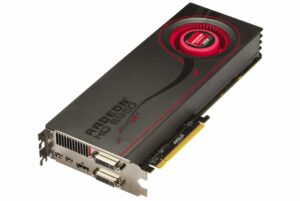AMD Radeon HD 6950 saw the light of the day on 14th December, 2010. This is a TeraScale 3 architecture desktop card built on a 40 nm manufacturing process. Indeed the AMD Radeon HD 6950 mainly aims at gamers. The Radeon HD 6950 is an AMD video card which comes under the category of Enthusiast. Indeed, it will support 78% of the top 10,000 PC games. It will also hold up 47% of these games at the recommended or best experience levels.
Technical specifications
The Radeon HD 6950 happens to be a performance-segment graphics card by AMD. It is developed on the 40 nm process, and formulated on the Cayman graphics processor. Indeed the card holds up DirectX 11.2 in its Cayman PRO variant. The Cayman graphics processor is a large chip which comes with a die area of 389 millimeter square. In fact, it offers 2,640 million transistors. The Radeon HD 6970 is entirely unlocked. Its GPU is identical to the Radeon HD 6950. However, AMD has enabled all the 1536 shaders on the Radeon HD 6970. On the other hand, AMD has disabled few shading units on the Radeon HD 6950 to meet the product’s target shader count. Thus, it offers 1408 shading units. It also comes with 88 texture mapping units and 32 ROPs.

AMD has combined 2,048 MB GDDR5 memory with the Radeon HD 6950, which are linked using a 256-bit memory interface. The GPU is functioning at a frequency of 800 MHz. The memory operates at 1250 MHz (5 Gbps effective). Being a dual-slot card, the AMD Radeon HD 6950 consumes power from 2x 6-pin power connectors. The power draw ranges at 200 W maximum. Display outputs consist of 2x DVI, 1x HDMI 1.4a, and 2x mini-DisplayPort 1.2
Radeon HD 6950 is linked to the rest of the system using a PCI-Express 2.0 x16 interface. The dimensions of the card are 286 mm × 126 mm × 42 mm. In fact, the card comes with a dual-slot cooling solution. When the AMD Radeon HD 6950 came into the world, its price was 299 US Dollars.
Probe into more details
The AMD Radeon HD 6950 graphics card is a high-end model that intends to bring DirectX 11 gaming to the people. Flaunting dual Cayman graphics engines, 2 GB of GDDR5 memory, stereoscopic 3D support, a BIOS toggle switch and Eyefinity multi-display technology, the AMD Radeon HD 6950 offers just about everything a hardcore gamer requires. It’s also remarkably affordable. The AMD Radeon HD 6950 is possibly not in the same league as Nvidia’s super-powerful GeForce GTX 580 graphics card.
However, it’s a lot more cost-effective. In fact, it is the most recent addition to the Cayman GPU family. It falls in between the mid-range Radeon HD 6870 and enthusiast-level Radeon HD 5970 in AMD’s desktop graphics line-up. Indeed, the 40 nm board comes with 1408 stream processors. The AMD Radeon HD 6950 offers a clock speed of 800MHz. In fact, it comes with a memory clock speed of 1.25GHz.

Design and connectivity
The AMD Radeon HD 6950 features a brick-like design that is identical to its high-end predecessors. However, a closer scrutiny discloses an improved vapour chamber heat sink and enlarged fan. Thus, these features let the card’s components remain cool during peak usage.
Indeed, the AMD Radeon HD 6950 comes with a good range of connectivity. It offers an HDMI output, two DVI ports and a pair of mini-DisplayPort connectors. In fact, the card also holds up AMD’s Eyefinity Technology which lets you drive up to three displays from a single card. Thus, this is particularly convenient for flight sim and racing fans, as it lets them set up an authentic ‘cockpit’ style view for increased immersion and authenticity.
Features and accessories
The AMD Radeon HD 6950 shares compatibility with HD3D – AMD’s take on Nvidia’s GeForce 3D Vision. Indeed, this technology comes with support for the Open Stereo 3D Initiative. Instead of bringing dedicated hardware into creation, HD3D offers support for a wide variety of technologies. This involves active-shutter or polarised glasses, along with emerging hardware, for instance glasses-free 3D monitors.
Indeed, the AMD Radeon HD 6950 caters surprisingly well to the overclockers. In fact, AMD’s PowerTune application lets you adjust clock speeds in real time by up to 20 percent. Indeed, the card offers dual BIOS chips – complete with a physical switch to toggle between them. This lets you revert to the factory BIOS settings if you face instability.

Performance
When we modified the core and memory clock speeds in PowerTune, we could tease a few more frames per second out of each gaming benchmark. For instance, Call of Juarez took a leap from 102.4 frames per second to 106.8fps. Similarly, Crysis Warhead escalated from 34.8fps to 36.6fps.
Also read: AMD Radeon HD 7970M: The Best-Ever Review
